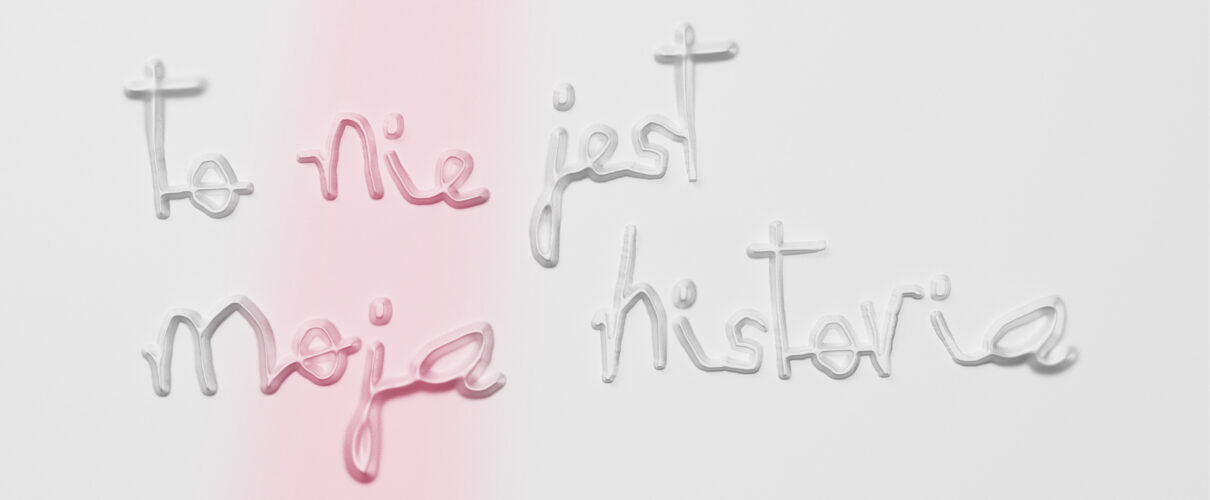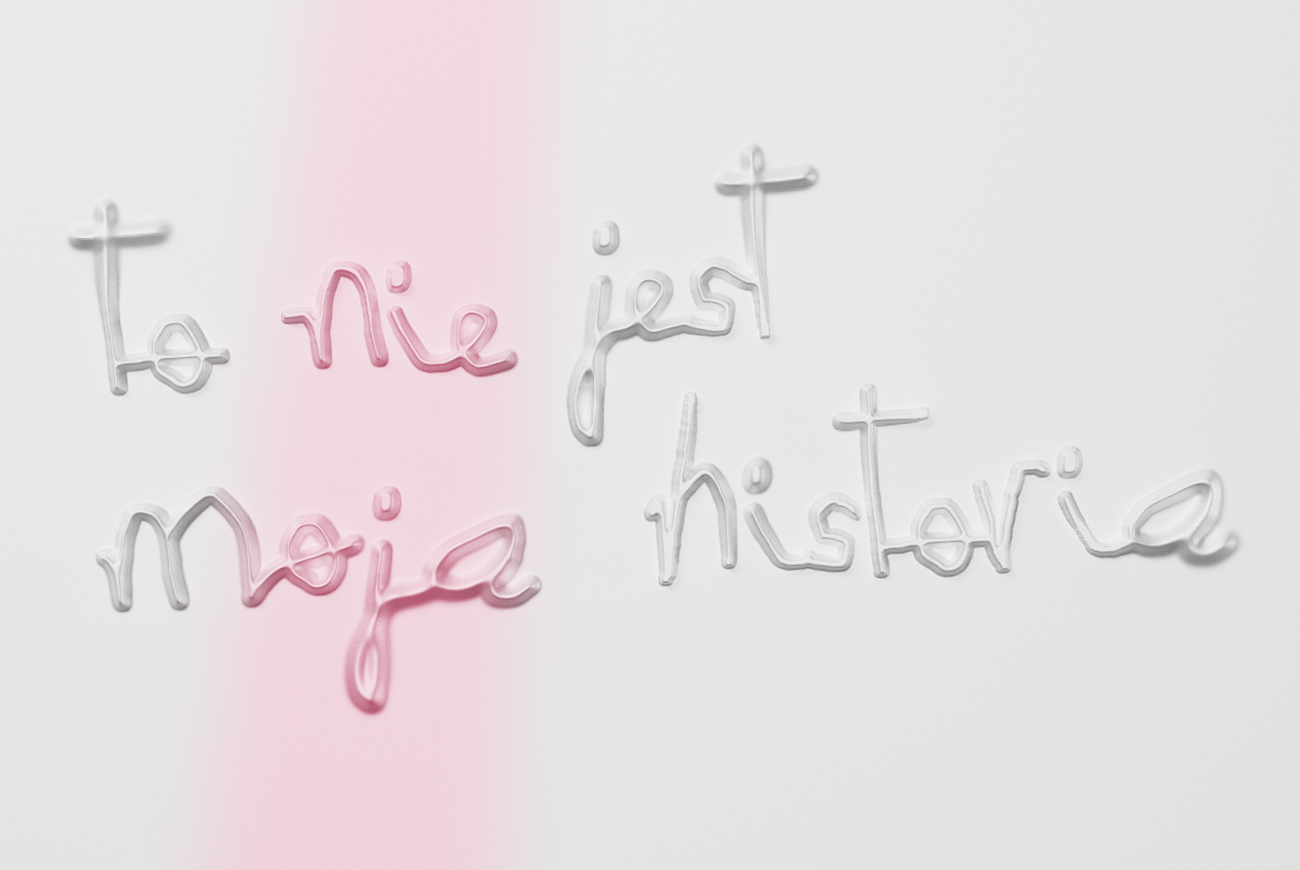EXHIBITIONS

September 28, 2023 - May 28, 2024
1 PLN, Thursdays: free admission
This Is Not My History

Children experience various forms of violence, most often from their relatives. They are disciplined, exploited, beaten, abused and raped far more often than one might think. They are systemically stripped of their subjectivity, denied voice and the right to autonomy. And when they do speak about endured suffering, adults ignore them, often downplaying kids’ emotions and failing to intervene when necessary.
The exhibition addresses the dark side of childhood, the injustice experienced by children, and the defence strategies they employ to survive. Drawing also on their personal traumas, the artists talk about growing up in poverty and disregard for the kids’ feelings, sexual violence, fear and about seeking emotional support in the world of fantasy. They take inspiration from children’s aesthetics – creatively transforming toys, furniture, domestic hideouts. They demonstrate that childhood – seemingly joyful and carefree – is in fact not devoid of violence, humiliation or neglect.
Philosopher Walter Benjamin understood childhood as a crisis: a period of suspension between adult reality and the world of imagination, the formation of one’s personality and the preparation for a life about which nothing is yet known. In his collection of essays Berlin Childhood around 1900, he recalled the world of his adolescence – life that was prosperous and relatively happy, but also full of difficulties, disappointments or constraints. In a sense, this is also his story.
According to the report published by the NGO Dajemy Dzieciom Siłę (We Give Strength to the Children) in 2022, as many as 41% of children in Poland experience violence from their adult relatives, and 57% – peer violence. In the same year, as many as 2031 children attempted suicide.
An explicit prohibition of parental beating of children was introduced into Polish law as late as 2010.
- Sebulec, Duszka, 2021, fot. z wystawy Helena Bohle-Szacka. Przenikanie, z archiwum artysty
- Patryk Różycki, Mama oddająca obrączki do lombardu, by mieć pieniądze na rachunki i jedzenie, 2022, dzięki uprzejmości artysty i Polana Institute
- Agata Jarosławiec, Tonic immobility 2022, fot. archiwum artystki
Objects on exhibition
Agata Jarosławiec, Tonic immobility, 2022, ceramic, fabric/installation
Title thanatosis (tonic immobility) is a state of physical motionlessness that is a natural reaction of the body in a state of acute danger or extreme stress. The potential victim pretends to be dead to discourage the predator: it protects itself from the attack by holding its breath and involuntarily twitching of the muscles.
In Agata Jarosławiec’s work, the victims are children – frozen with fear, hiding behind a curtain. The installation tells the story of bodily memory, intergenerational trauma and emotional paralysis, which is both a fight and a flight.
Patryk Różycki, Mother Leaving Wedding Rings at a Pawn Shop to Pay the Bills, 2022, oil on canvas
In his autobiographical paintings, Patryk Różycki recalls scenes from his everyday life, emotional states and often traumatic childhood memories. The work on display is an attempt at working through the experience of poverty in which his family found itself during his father’s illness. The mother’s earnings were insufficient to cover the family’s basic living expenses.
In Poland, 1.6 million people live in extreme poverty, with the largest group being children – as many as 330,000.
Bolesław Chromry, Without title, 2022, acrylic, lacquer/wood
Boleslaw Chromry placed the face of a smiling priest on a child’s wooden chair. The work critically addresses the crime of pedophilia and the systemic protection of sexual predators in the Roman Catholic Church. Clergymen who molest or rape children are not tried and convicted under secular law but transferred to other parishes. The scale of abuse is enormous and consistently underreported, and regulations do not protect minor victims.
Weronika Perłowska, From the series Anger Is Bad for Beauty, 2020, video, 0’9”
In a short video one sees an eruption of anger in a little girl. The embarassed several-year-old cries, throws a pillow and leaves the room where she was filmed by her parents just a moment earlier. The footage comes from the artist’s home archives and was shot in 1998. The title of the series – a well-known Polish proverb – refers to the cultural suppression of female anger. Perceived as ridiculous or hysterical, it is socially unacceptable, and angry girls are threatened they might become ugly.
Sebulec, Dushka, 2021, synthetic fur and filling, plastic/sewing
Dushka is an oversized toy made of pink synthetic fur. It is soft, delicate and can be touched or cuddled. It was inspired by the drawings of fashion designer and graphic artist, concentration camp survivor Helena Bohle-Szacka. It is a gender-neutral figure – a product of imagination – who protects, reassures and supports. She soothes through touch – both old, healed traumas, and the recent ones: the humanitarian crisis at the Polish-Belarusian border, the full-scale Russian invasion in Ukraine, political violence against the LGBTQ+ community. Dushka embodies one of children’s defensive strategies: seeking solace in a fantasy world.
COLOPHON
artists Bolesław Chromry, Agata Jarosławiec, Weronika Perłowska, Patryk Różycki, Sebulec
curator Zofia Rojek
cooperation and translation Katarzyna Bojarska, Adam Lipszyc
exhibition design Maria Ostaszewska-Cichocka
production Katarzyna Jolanta Górska
editor Urszula Drabińska
poster ang graphic materials design Sebulec
partners Fundacja Współpracy Polsko-Niemieckiej, IFiS PAN, Uniwersytet SWPS, International Walter Benjamin Society
thematic path through the main exhibition of the Museum of Warsaw
texts and translation Katarzyna Bojarska
selection of objects Zofia Rojek
cooperation Adam Lipszyc
production Katarzyna Jolanta Górska






